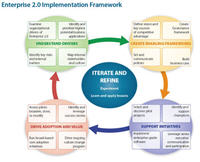10 DOs and DONTs of organizational change
For a recent boardroom presentation to a group of CEOs of large organizations I prepared ten ‘dos and donts’ on my topic of organizational change.

Enterprise 2.0 Implementation Framework
I drew on the core ideas in our Implementing Enterprise 2.0 report and framework (as above). Enterprise 2.0 is ultimately far more about organizational change than technology, though it happens to be driven by web technologies. As such much of my focus today is on how to change organizations, to literally create the next version of the enterprise. Far more details on how to put the ideas below into practice are in the Implementing Enterprise 2.0 report.
My list got an extremely positive response from the audience, so I thought I’d share it here.
DOS
1. Create a vision
The most important aspect of your vision is that it must be compelling. Unless people are drawn to it and want to help create it, it is useless. This means it needs to be focused on the benefits to everyone in the organization.
2. Set and communicate policies
Policies provide parameters in which people can freely play. Without guidelines staff will either be reluctant to try things for fear of going too far, or will do inappropriate things because they haven’t been told otherwise. Simple, clear policies are a powerful enabler of positive change.
3. Select and discover pilots
Pilots are the instrument of experimentation, of trying new things within safe boundaries. Choose what new things you want to try and how to go about it, so you find out what works and how to scale it across the organization. However the most valuable experiments are probably already happening, so you need to discover and nurture them.
4. Identify and support champions
Every organization that has rapidly and successfully changed has depended on champions that have provided a lead for others. In many cases they are informal champions, driving change through their enthusiasm and energy. Don’t manage them, but find them and support them.
5. Iterate!
We are living in what I call “The Heuristic Age,” in which everything is driven by trial and error. Grand plans will never succeed (as planned) in a complex world. The key driver of change must be trying things, learning from them about what does and doesn’t work in your unique organization, and trying again being a little bit wiser.
DON’TS
1. Ignore concerns
Everyone – from corporate directors through entry-level staff – will be worried about change. Do not ignore these concerns but address them. If they are unjustified, show why. If they are justified, assess real risks and rewards and act to swing the balance to the rewards.
2. Start with technologies
Many people are excited by the plethora of awesome technologies we now have available. It is a mistake to start with a technology and try to make it useful. That approach usually fails. Instead start with business issues and see what technologies can help them.
3. Create a master plan
While you need a vision, you shouldn’t create a fixed master plan of how you’ll get there. It’s a delicate balance, as you do need a roadmap of where you think you’re going. However the temptation can be to get too detailed and too prescriptive. Any plan must allow for development, learning, iteration, and change.
4. Let pilots run indefinitely
Pilots are a tool of finding what works. That means you need to clearly distinguish between what is working and what isn’t. If things aren’t working, either close them down or change them dramatically. It is easy to set up pilots. It is harder, but just as important, to close them down if they are not creating value.
5. Try to do everything
With so many opportunities for positive change in organizations, it is tempting to try to do it all, to truly transform the organization into a far more effective machine. The chances of success are minimal, and the risk is failure means everything stays at the status quo. Contain your ambitions and move by steps rather than leaps, at least initially.
